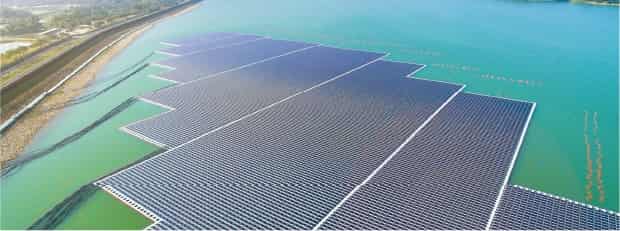The Future of Asia’s Energy Sustainability
DBS is catalysing change for a cleaner, greener and more energy-independent tomorrow

Fuelled by rapid urbanisation and population growth, energy demand in the Asia Pacific is expected to double by 2030. Yet, there is an increasing deficit between the region’s existing energy infrastructure and what is required to meet future needs. If the situation persists, energy inequality will continue to widen, contributing to other socio-economic challenges.
To overcome these infrastructural constraints, Asia requires innovative technologies and solutions that can generate power in a socially, economically and environmentally sustainable manner. Through our investments in renewables and sustainable infrastructure, DBS is bridging the energy gap and catalysing change for a cleaner, greener and more energy-independent tomorrow.
Renewables: the answer to Asia’s escalating energy demands
Southeast Asia has one of the world’s highest rates of energy demand, driven by economic growth, rapid urbanisation and industrialisation. The region’s demand for oil and electricity alone has grown 80 per cent since 2000, twice as fast as the global average.
To achieve its sustainability goals, Asia must add renewables into its global energy mix and establish infrastructure to support the rapid development of its clean energy solutions. Only then will its fast-growing population have equal access to affordable, reliable and sustainable energy.
But while renewable power is the solution that will help meet accelerated energy demands in Asia, the transition to clean energy has been progressing slower than what is required to fulfil the United Nations 2030 Sustainable Development Goals (SDGs). These goals include Affordable and Clean Energy, Sustainable Cities and Communities, and Responsible Consumption and Production.
Approximately only 27 per cent of power in Asean is currently renewable, which needs to double to around 52 per cent by 2030 if we are to meet the UN’s sustainability goals. This ambition requires an additional US$70bn in investments.
Emerging opportunities for Asean’s renewables sector
COVID-19 has had an enormous impact on every sector, but none as immediate as the global fall in energy usage. Remote working arrangements, social distancing and lockdowns further curtailed electricity demand, which has slowed the growth in demand for traditional fossil fuels.
“COVID-19 has muted energy demand in Asia, but the impact varies across countries”, shares Kelvin Wong, Managing Director, Project Finance at DBS.
In a time of global economic crisis, when investment appetites have lowered, and large or billion-dollar investments have become less attractive, renewable energy has emerged an unexpected winner.
“The slowing growth of energy demand has opened up new opportunities for bite-sized renewable energy developments such as lower-megawatt solar plants and smaller-scale wind and hydro systems,” Wong elaborates.
Subash Narayanan, Deputy Head of Project Finance at DBS, concurs. “As the quantum of growth for traditional energy has slowed, renewables can come in to fill the gap,” he shares.
And this shift in priority will result not only in renewed investment opportunities but also an increase in the percentage of energy generation from renewable sources across the region.
Innovative solutions to overcome Asean-specific challenges
Yet challenges remain. One of the most significant is the land requirement for development of renewables infrastructure, which far exceeds that of traditional power plants – a solar plant can require four times the land area of a thermal plant. And with the scarcity of land in Southeast Asia, renewable energy projects are competing with agriculture, industry and growing populations.
As a result, innovative solutions are needed – while Southeast Asia is scarce is land, it has an abundance of water. The Changfang and Xidao projects, Taiwan’s landmark floating solar and offshore wind developments, have been examples of alternative methods of progressing renewable projects that circumvent traditional challenges.
Another example is Singapore’s first single large-scale floating solar project in Tengeh Reservoir in Tuas, recently announced and to be undertaken by Sembcorp. When completed, the solar plant will be one of the world’s largest, inland floating solar photovoltaic (PV) systems, covering an area of approximately 45 football fields.
Other areas of Asia are also poised to seize the potential of offshore wind and floating solar projects. With one of the longest coastlines in Asia, Vietnam is rich in wind resources, and with high energy demands coupled with ambitious renewable energy targets, there is great opportunity to incorporate these types of projects into the mix.
“Wind and hydro in Vietnam present big market opportunities,” says Wong. “The successes in Singapore and Taiwan have encouraged investors to replicate similar solutions like hydro dams and floating solar power plants to overcome land constraints common across ASEAN.”
The future of Asia’s transition lies in energy storage
Another challenge to large-scale energy transition is related to energy storage – renewable energy has a significant impact on the stability of electricity grids. Wind and solar plants produce energy when the wind is blowing, or the sun is shining, fluctuating supply to the power grid. Adding even more renewable energy sources into the mix only increases this unpredictability, leading to grid instability and potential failure. Batteries – usually lithium-ion – have also become a critical factor in the success of renewables and are particularly crucial in areas not connected to a strong power grid.
Technological innovation designed to increase transmission capacity and develop smarter grid management systems is needed to address these challenges. Research into better utility-scale batteries is also required to provide greater feed-in of renewables into the grid by storing excess generation and regulating renewable energy output.
“Governments usually fund the development of transmission grids and energy storage solutions, but these sectors are gradually privatising, especially in Asia,” shares Narayanan. “And with more government concessions and regulatory support in the form of Public-Private Partnerships (PPP), there is significant risk appetite from private investors to enter these sectors.”
With challenge comes opportunity – as the momentum for energy storage systems builds in Southeast Asia, investment opportunities in the renewables sector are incredibly strong, not only in the deployment of projects but in the manufacturing of components as well. Malaysia is currently the third-largest producer of PV cells, while increased investment in Thailand’s solar manufacturing industry is increasing PV output for global markets. With companies such as Apple committing to becoming carbon neutral throughout its supply chain by 2030, the flow-on effect for suppliers in the region is enormous. Significant investment will be needed for the development of rooftop, hybrid systems and onshore wind projects, presenting huge opportunities for the entire renewables sector.
DBS is dedicated to Asia’s sustainable future
Since 2018, DBS has completed 29 renewable projects across Asia amounting to around SGD3.6 billion. As the sole financier of the Tengeh Reservoir project, we are building on our financial advisory roles in Taiwan’s largest floating solar project and the largest ground-mounted solar project.
But while financing renewable energy projects sits at the core of DBS’ agenda, capturing financial advisory opportunities early to shape and influence the market is what sets us apart from other financial institutions. As a bank with extensive operations across Asia, it is not enough for us to participate – we want to have a constructive presence in driving a more sustainable and equitable future in the region.
And despite the challenges of COVID-19, DBS has continued to remain active in the renewables sector, with four new advisory mandates across the solar, wind and geothermal assets in Indonesia, Taiwan and Vietnam acquired thus far in 2020.
Find out more about our renewable energy financing and advisory services here.



